Author: hoeem Source: X, @crypthoem Translation: Shan Ouba, Golden Finance
Has the bull run even started?You might see the title of this article and think: "Is this person crazy?" Then after reading it, you think: "I have to prepare for the bull run."
Yes, Bitcoin has risen from $16,000 to $110,000 in the past three years, but has the bull run really started?
I know it sounds like crazy talk, but there is some reasonable evidence that it hasn't really started yet, because the macroeconomic environment has not yet created the conditions for a "real" bull run.
We have indeed seen the largest institutional adoption of Bitcoin in history, but what about altcoins? They seem to have been suppressed throughout the cycle, repeatedly entering small bear markets.
I watched a video by @Jesseeckel on YouTube where he dives into what sparked the bull markets of 2013, 2017, and 2021. No, it wasn’t just a four-year cycle. There was more to it. And we haven’t seen similar conditions since…yet. So I decided to turn his video into an article.
If you look at what ignited the “mania,” it wasn’t narrative, it wasn’t blind hope, it was macro liquidity mechanisms. And we’re only in “Act 1” right now.
Jesse came up with a concept called the “11 Rings of Liquidity Power.” The 12th Ring of Power is the core that governs it all.
If you want to know:
Why past cycles suddenly broke out
What macroeconomic tools are really injecting momentum
And what triggered it all to start
Then you must read on:
Why the crypto bull market has not started yet
A complete macro framework to help you accurately judge the timing before the next craze begins. How Liquidity Entered the “11 Rings of Power” of the Crypto Market:
All big crypto bull runs have one thing in common: they all coincide with a huge injection of liquidity in the global economy. These liquidity surges are not random events but are initiated by central banks and fiscal authorities, pulling one or more of the following macro levers:
Rate cuts - lower borrowing costs and encourage debt-driven growth
Quantitative easing (QE) - central banks buy government bonds to inject cash into the system
Forward guidance (promises not to raise rates) - influences market sentiment by signaling expectations of future low interest rates
Rate reductions - banks have more money to lend
Capital relaxation - reduces constraints on institutions taking on risk
Loan forbearance – Keeping credit flowing even if there are defaults
Bank bailouts or guarantees – Preventing systemic collapse and restoring confidence
Massive fiscal spending – The government injects money directly into the real economy
Release of funds from the U.S. Treasury General Account (TGA) – Injecting cash from the Treasury account into the market
Overseas QE and global liquidity – The actions of other central banks affect the crypto market through capital flows
Emergency credit mechanisms – Temporary lending tools established during crises
These actions not only drove up traditional assets, but also triggered what Jesse called a “speculative frenzy.” Cryptocurrencies, as the riskiest but most promising asset in the system, tend to benefit the most. Each “ring of power” is activated to a different degree. But when multiple are activated at the same time, the effect is exponentially amplified, bringing a frenzy of gains to various markets. One ring to rule them all: Economic pain At the heart of the 11 levers of power above is “economic pain.” Only when there is enough pain in the economy—financial crisis, recession, layoffs, industrial collapse—will policymakers act. Without pain, few people will move these levers. And once pain is apparent, they are pulled fast and hard.
A few historical examples:
2008–2009: Financial Crisis → Full QE, zero interest rates, massive bailouts
2020: Pandemic Crash → Unprecedented global liquidity injections, stimulus checks, record money supply growth
Now: Although we have just experienced the fastest bear market crash in stock market history, is it really painful enough? So far, these power rings have not been fully activated. And the relevant authorities are still very "stubborn", especially when we have rebounded strongly.
More signs: Not long ago, the Richmond Fed Manufacturing Employment Survey showed -18, which is worse than -12 in 2020 and -14 in 2008, indicating the risk of large-scale layoffs in the industrial sector. This is an important data that the Fed is using.
Most of the "Rings of Power" Have Not Been Activated Yet
Despite the recent gains in the crypto market, the real bull run has not yet begun. Most liquidity levers are still closed or tightened, and while the direction is right, no major changes have taken place at the moment.

Without a large new injection of liquidity, the previous market frenzy conditions cannot be replicated. This is why the recent rise is an orderly, institution-driven rally, rather than a crazy bull market driven by retail investors. There is simply not enough "free money" in the system to create a real frenzy.
Historical Bull Market and Liquidity Background
2013:
Interest rate is 0%
QE (Quantitative Easing) is fully launched
Government spending increases
→ Bitcoin rises from less than $15 to over $1,000
2017:
US interest rates are still low (although they are starting to rise slowly)
The liquidity released in 2016 continued
→ Bitcoin rose from about $1,000 to nearly $20,000, and other currencies also rose explosively
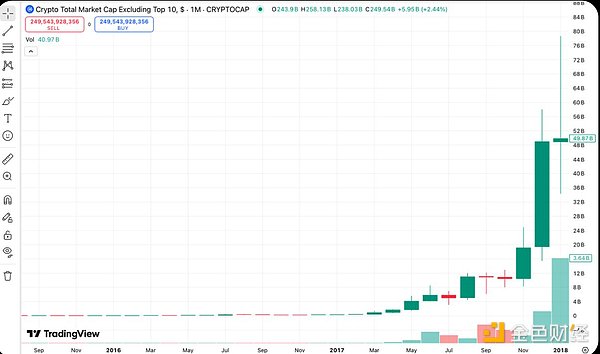
(2017–2018 Altcoin Market Cap Chart)
2021:
All liquidity levers are fully opened
M2 (broad money supply) increased by more than 25% year-on-year
→ Bitcoin reached about $69,000, and other currencies exploded
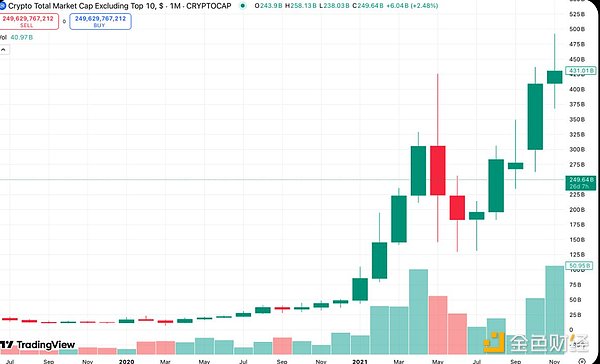
(2021 altcoin market value chart)
Every bull market occurs after a surge in liquidity. Look at the performance of other currencies, and then look at the year-on-year growth rate of M2 at that time:
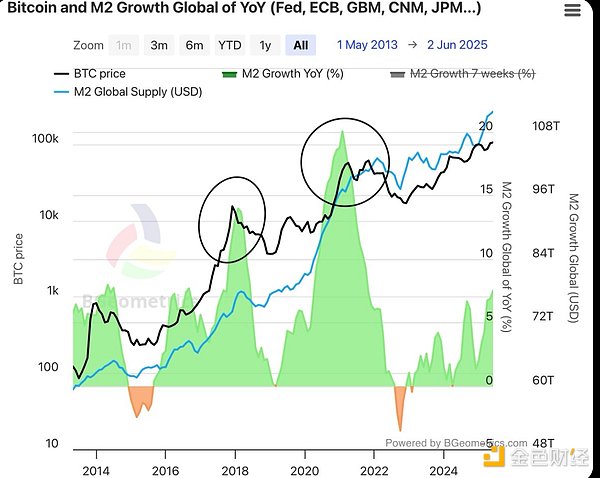
Key Signals: M2 and PMI
There are two indicators that are always closely related to crypto bull markets:
1. M2 Broad Money Supply (Year-on-Year Growth)
Tracking the rate of money growth. Before all major market movements in history, M2 has grown rapidly. At present, the M2 growth rate is roughly flat. Although there is an upward trend in some areas, it is far less than the level before the previous bull market → This is a clear signal: The driving force for economic recovery has not yet arrived.
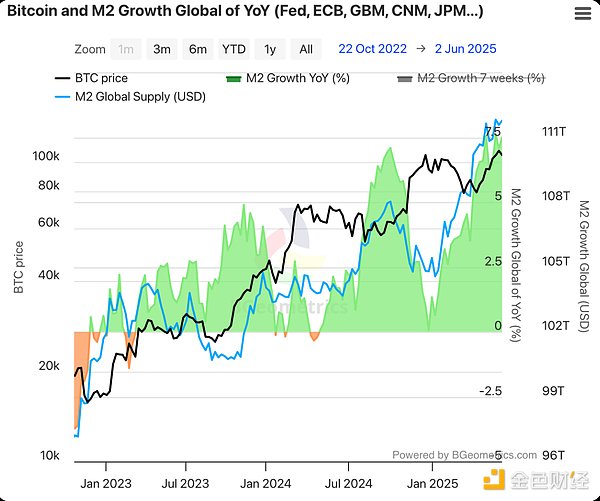
2. ISM Manufacturing PMI (Purchasing Managers Index)
A reliable business cycle indicator. PMI above 50 indicates economic expansion. Historically, when PMI approaches or exceeds 60, the crypto market often ushered in a big market.
In this cycle, PMI barely touched 50 before falling again.
The data shows that the macro environment has not completely changed, which is why we have not seen a real frenzy.
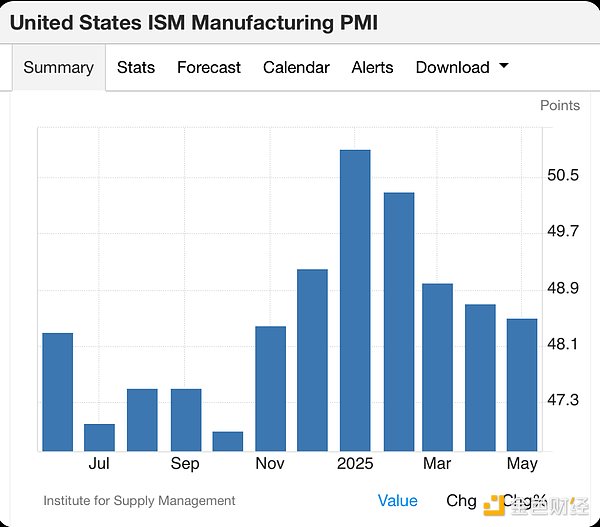
Conclusion: The bull market is still "loading"
Every round of crypto bull market in the past appeared after the macroeconomic pain point triggered a wave of liquidity. And now, the pain is brewing, but the policy measures have not yet arrived.
Most of the "11 liquidity power rings" are still closed. Only when economic difficulties force policymakers to activate them will we usher in the environment for the next round of speculative frenzy.
In the short term, cryptocurrencies may continue to rise slowly, but if liquidity does not really pour in, the market will still be fundamentally limited. The real bull market begins when the power rings light up
 Alex
Alex
 Alex
Alex Catherine
Catherine Alex
Alex Joy
Joy Kikyo
Kikyo Weiliang
Weiliang Weiliang
Weiliang Catherine
Catherine Anais
Anais Kikyo
Kikyo